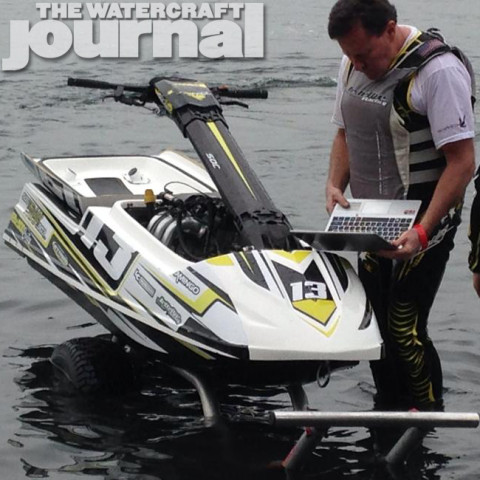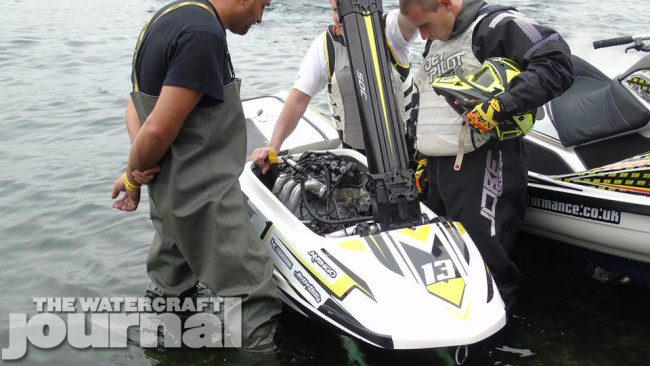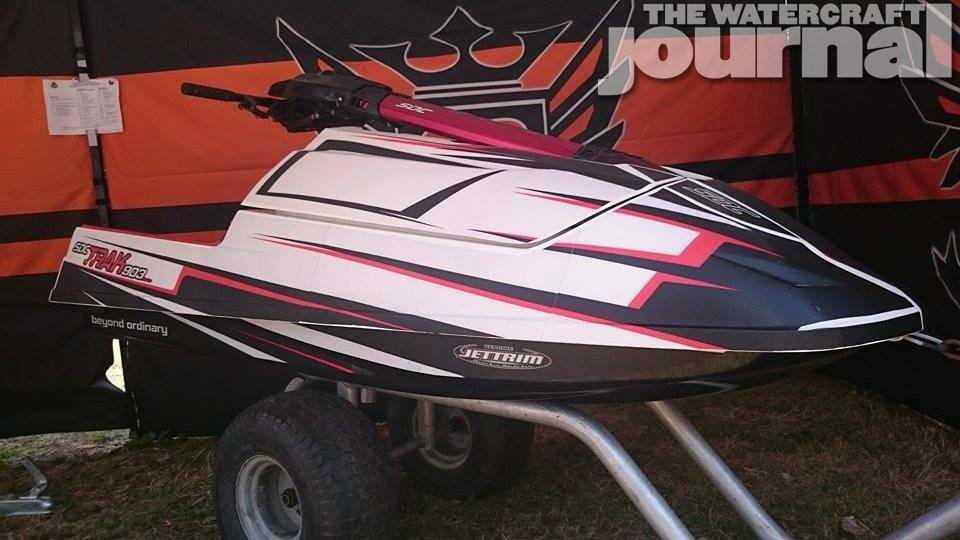Over a month ago, The Watercraft Journal brought you a whole lot of leaked information on Les Cooke’s all-new brainchild, the Sea-Doo Centre SDC Trak 903 standup ski. As per our article, the SDC Trak 903 debuted at the 2015 Jetcross World Cup in Doncaster, UK. Now, after the race and the Trak’s unveiling, The Watercraft Journal sat down with multi-world champion Kevin Reiterer who raced the Sea-Doo Centre ski and played a major role in its development:
The Watercraft Journal: So what can you tell us about the new Sea-Doo Centre SDC Trak 903? What is it?
Kevin Reiterer: It’s basically a Sea-Doo Spark engine in a stand up hull [that] Sea-Doo Centre created in Melbourne, Australia. It’s a new innovative ski and hull, easy to work on for the everyday person, to just hop on, have a great ride on it. Also developed for the racers for Pro classes to ride at the top.
WCJ: What’s under the hood? Tell us about the motor? How about the pump?
KR: Sea-Doo Spark engine that’s naturally-aspirated which will be available next year for the public. On the GP version, we added the turbo.
We are trying to keep the cost down on the naturally-aspirated ski so that will have the Spark pump in it and for the GP ski we are working with the Solas pump at the moment but we aren’t too sure where we will end up with the final pump set up when we get more power from it.
WCJ: What else is used from the Spark?
KR: Basically as much as we can! So we have the stock ECU in the naturally-aspirated version. We’re using the harness, wire loop, throttle sensor and throttle lever, the start and stop. The dashboard, which is a cool feature on that ski, changes between modes to see the rpm of the ski, like the Spark.
WCJ: What can you tell us about the hull design?
KR: Sea-Doo Centre started two years ago with the hull design on the Hydrospace where they changed the hull itself to make it fit for [bigger] horsepower skis. That was the base of the new concept; they did some major changes to it for the normal public as well and still work for the GP skis.
Then they created a new top deck, with the top deck they did a really great job because you can put in any engine you want, as there is a really big engine space, where you can look in and work on the engine itself. The tray is pretty much equal to the Hydrospace just a little bit wider.
WCJ: How long has this been in development? How long have you been involved?
KR: It started at the end of last year, working all winter on it. I’ve been going to Australia for a few months for final developments in putting all the stuff together and when they were actually ready to put it on the water. I tested with them for a month in Australia and then they shipped the ski to Europe. I’ve been working back and forth with them, giving them feedback on the ski, with handling and stuff we have changed during the last couple of months.
WCJ: How does it feel compared to your Hydrospace S4?
KR: It’s feels pretty different. [laughs] The biggest change is the power on the ski. It really feels snappy like a 2-stroke. It has a three cylinder engine in it so it’s really snappy, [it] has really good power… This weekend we started really testing it for the first time in a race. We still did some major changes to it so we’re still not where we want to be with the ski but we’re going in the right direction. Every moto got better and better.
WCJ: How is the weight?
KR: It’s 60kg (132 pounds) lighter than the original Hydrospace.
WCJ: How’s the handling?
KR: It’s in-between the Hydrospace and the Yamaha, so it has a little bit more stability, drive in the chop and out of the turns. [You] can lean it in like the Yamaha so you can go full speed, sweeping corners and the ski will just stay there and drive.
WCJ: How did you feel it did on the racecourse?
KR: We had some spark plug problems in the first moto, which were really unfortunate. But we fixed the ski, we did some handling changes in-between motos. I want it to handle as good as my Hydrospace (or even better) and we are getting there. So basically, the hull is pretty much the same as the Sea-Doo Centre hull I’m using on my Hydrospace, I want it to be as good as that so we are definitely a step in the right direction.
WCJ: What are the projected production numbers?
KR: It’s hard to say, estimated they will try to 300-400 selling next year. It depends on the request on the market for production but they are planning for the first container to leave Australia around the end of the year; maybe November to Europe.
WCJ: And lastly, how much will it cost?
KR: We’re still figuring out the price but we want to do a kit so any customer can bring the dealer the Spark and say, “Hey I want a stand-up.” The dealer [will have] the parts and everything else it needs to put in the ski to transform it into a stand up, so it should be pretty easy to do. It will hopefully get a lot of new people into the sport as well.
[According to James Bushell’s 158 Performance, prices start from £9,800 ($15,250). – Ed.]
Interview conducted by Lisa Gilbert. Additional images provided by Kevin Reiterer and Daniel McKey









































in the article it says the boat is 132 pounds lighter then the original hydro,,, i believe the engine is 60 pounds lighter then the weber motor…. i cannot say what the total weight is but the 2004 originals hydro was 369 pounds the 2007 with a thicker bottom deck was 385 pounds and the 2011 with the regular plastic hood was 400 pounds so i am guessing the this new boat weighs in at around 351 pounds but what do i know
At $15K plus how many “new” people are you going to get, LOL.
if I own a Spark, how can this kit make it a stand-up ? its a different hull design.
You would take your Spark to a licensed dealership where they would open it up, pull all the guts out of it and transplant them into the standup ski. What you’d be left with is a new 4-stroke standup, and a completely empty husk of a Spark.
So the $15k would be for the new empty Sea-Doo standup hull and the cost of the dealership to install your motor and hardware? So you will need to already have a Spark, or will have to buy one first to make this kit work?
Right now, James Bushell’s 158 Performance is selling a naturally-aspirated Trak standup for just over $15,000. That is in fully running order. What this leaves one to speculate (because finalized ordering has not been established), is that similar kits would be priced at just below $10,000, with the cost of a sacrificial Spark being between $5-6,000. A dealer would then need to gut the Spark and transfer everything to the new Trak hull, leaving an empty Spark carcass.
well i bought this boat and on the ski doc it feels so much lighter then the hydro since i have two hydros…. riding it is way more fun because of it acceleration… it totally out accelerate s very high priced two stroke triples from buoy to buoy but with a long start the triple is gonna smoke it…. short start and no problem racing against open and gp triples…. it turns on a dime… sweeps ….loves chop… and just runs and runs and runs and gets incredible gas mileage… one tank is 240 laps on the large body beach track…one drawback is the overall top speed so if your a drag racer you will get pulled … the top speed stock is around 52 mph but top speed does not mean nothing on a buoy track… i am gonna do some things to bring the top speed to 60 or near there and that will be nice but right now the boat is fun as hell to ride… the reason i want 60 is the new yamaha will be 61 out of the box so i don’t want my wife that much faster then me……